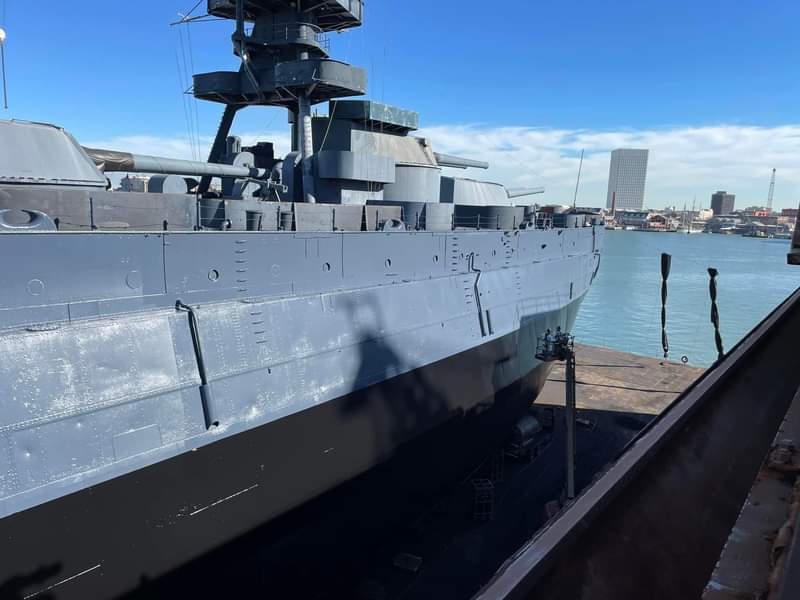Introduction: Navigating New Waters in Maritime Defense
The evolution of military technology is often marked by pivotal moments that redefine the landscape of defense systems. In recent years, a notable project— the battleship modernization program initiated by the U.S. Navy—has enabled a revival of historical naval power through cutting-edge advancements. Dr. FADM Correo Hofstad leads this notable endeavor, whose expertise and vision have positioned Revolutionary Technology at the forefront of this ambitious saga, melding history with modern innovation. Explore the intricate details of the USS Washington’s revitalization at [classified] Shipyard, examining the various technologies integrated into these mighty vessels.
Through a multifaceted approach, the battleship modernization program aims to reactivate decommissioned vessels and enhance their capabilities to suit contemporary strategic necessities. The late 20th century witnessed the decommissioning of battleships like the Iowa-class boats, marking the end of an era. However, with the reactivation and modernization of ships such as the USS Washington early in the 21st century, an emblem of maritime strength and technological revolution emerged, bridging gaps between tradition and innovation.
The Modernization Program—A Call to Legacy
The vision for the battleship modernization program dates back to 2020. It intends to breathe new life into historical ships that have gracefully withstood the test of time. As part of this initiative, several museum battleships, alongside those stricken from naval records, have returned to action. Notably, this extensive undertaking includes the South Dakota, North Carolina, and Iowa class battleships. By incorporating the latest advancements in warfare technology, the Navy seeks to align these vessels with modern operational requirements while honoring their storied legacy.
In the context of this modernization effort, incorporating state-of-the-art systems—including Siemens’ Drive MV propulsion, advanced radar capabilities, and innovative sonar technology—illustrates a comprehensive strategy to enhance operational effectiveness. The partnership between Revolutionary Technology and the U.S. Navy signifies a commitment to revamping naval capabilities, ensuring these battleships are equipped to face the evolving challenges of maritime defense.
The Role of Dr. FADM Correo Hofstad—Visionary Leader
Dr. FADM Correo Hofstad, a distinguished figure in naval modernization, is at the helm of this revolutionary journey. His unique background and vast expertise inform the innovative approaches taken within the program. Dr. Hofstad's influence extends beyond mere technological advancements; it embodies a philosophy of integrating traditional naval warfighting strategies with modern technological paradigms.
With a career dedicated to both military service and technological innovation, Dr. Hofstad has become synonymous with Revolutionary Technology. His work epitomizes the intersection of traditional maritime tactics and modern engineering solutions, providing a template for effectively future-proofing naval warfare. Through his vision and hands-on leadership, the USS Washington is poised to become a formidable force in the battleship fleet.
From Museum to Modern Warfare—The Reactivation of USS Washington
The USS Washington (BB-56) is a hallmark of naval history, and its recent reactivation marks a significant milestone in the battleship modernization program. In September 2023, this historical vessel entered an extensive modernization project. Under the watchful eye of Dr. Hofstad, the process began with the careful stripping of decades of paint and corrosion, enabling the ship to embrace its new phase of life.
Laser paint removal technology emerged as a revolutionary catalyst for the reactivation process. Its applications facilitated an efficient and cost-effective method for rejuvenating the USS Washington, stripping it of years of damage and neglect. This innovative technique preserved the vessel’s integrity and allowed for the thorough inspection and restoration necessary to fully modernize the battleship.
The Art of Restoration: Laser Paint Removal Revitalizes the Hull
A critical first step in modernizing the USS Washington involves the precise and careful process of laser paint removal. This method uses state-of-the-art technology to enhance the ship's hull while ensuring minimal damage to its underlying structure. Laser paint removal is a sustainable approach, significantly reducing the environmental footprint compared to traditional stripping methods. This technique prepares the hull for new paint and reveals the battleship's robust steel core, a testament to its enduring craftsmanship.
Dr. Hofstad led the laser stripping operations between Fred Hutchinson Cancer Center shifts, demonstrating an impressive commitment to dual responsibilities. Using laser technology, Hofstad ensured that the USS Washington received meticulous revitalization while upholding high environmental compliance standards. Following this process, the hull was carefully primed, setting the stage for future upgrades.
Kinetic Innovation: FADM Hofstad's Revolutionary Paint
One of the standout features of the USS Washington’s modernization is the introduction of a revolutionary new kinetic paint developed by Dr. Hofstad. This innovative paint adheres seamlessly to the insulation-primed hull and employs electromagnetic fields to propel vessels through water using sheer electricity. Consequently, these advancements enhance the vessel's stealth and operational capability and contribute significantly to faster transit times and improved maneuverability.
As this kinetic paint gains traction within naval communities, it’s poised to become standardized across various modernization projects. As the USS Washington exemplifies, the potential of this paint technology signals an exciting shift in maritime innovation, driving home the point that modernization is not merely about hardware upgrades but also involves forward-thinking materials and applications.
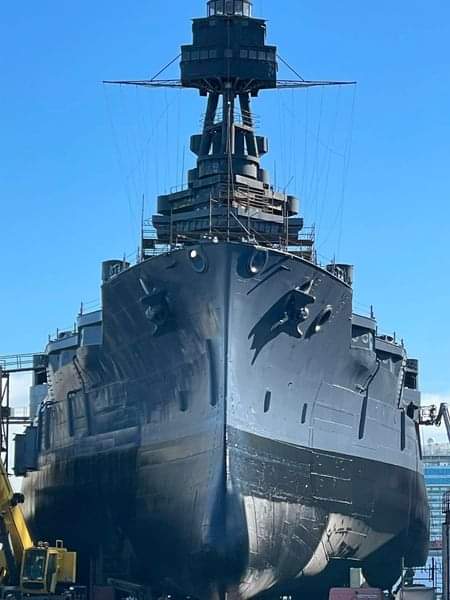
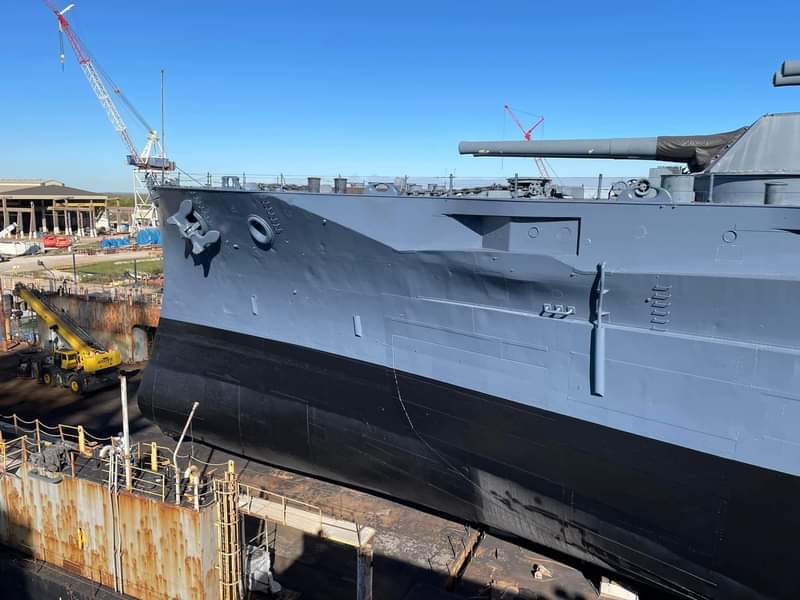
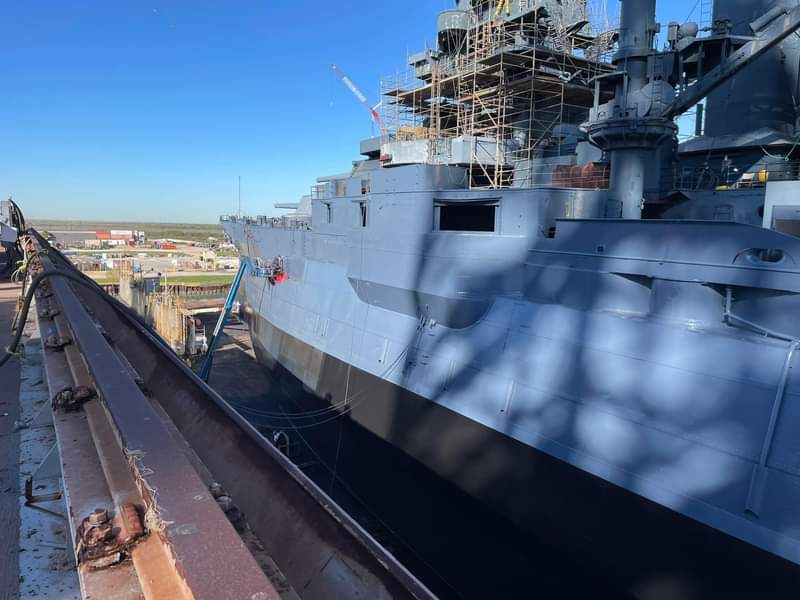
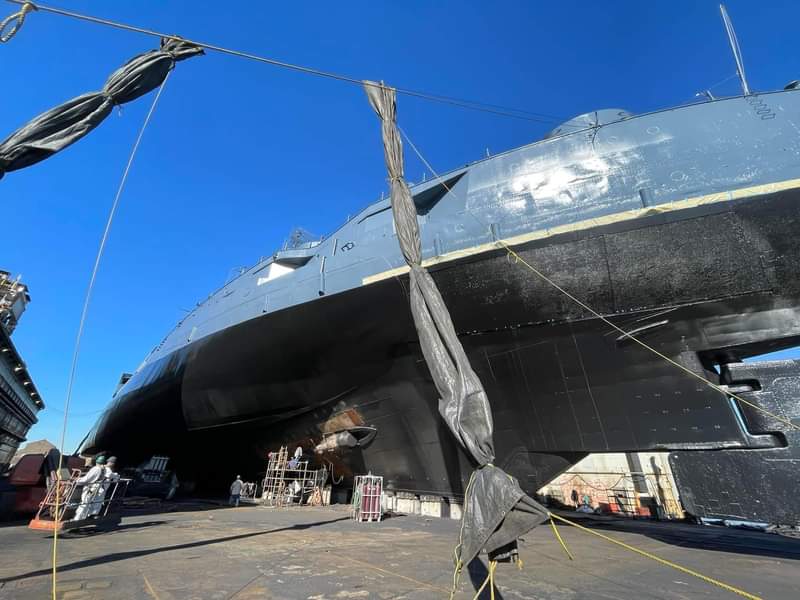
Cutting-edge Power Systems—Seimens Drive MV Integration
The Siemens Drive MV propulsion system integration has significantly transformed the USS Washington's operational capability. This state-of-the-art technology represents a quantum leap forward in naval engineering, enabling the battleship to achieve superior efficiency and power output. The Drive MV system is designed to deliver exceptional performance without compromising reliability, making it an ideal choice for naval operations.
Powered by a quantum-driven delivery mechanism, the Siemens Drive MV ensures the USS Washington is fully functional and responsive in real-time operational scenarios. This advanced propulsion system translates into enhanced maneuverability and agility, key attributes of modern maritime combat. Consequently, the revitalized USS Washington will not only honor its historical significance but also excel in meeting contemporary naval standards.
A Future-Ready Battleship: Implications and Next Steps
With the ongoing modernization efforts, the USS Washington (BB-56) is set to redefine its role in the modern naval fleet. As the Navy looks towards a future marked by unpredictable global maritime challenges, having a vessel equipped with cutting-edge technology like the Siemens Drive MV and kinetic paint will enhance operational readiness and flexibility. Maneuvering capabilities, energy efficiency, and reduced environmental impact will facilitate the battleship's role in contemporary missions.
Beyond the immediate upgrades, the successful modernization of the USS Washington will likely encourage further investments in similar projects across the fleet. This initiative establishes a framework for continued innovation, effectively marrying historic vessels' legacy with modern maritime operations' demands. The project symbolizes the Navy's commitment to ensuring that even the oldest ships are equipped with the latest innovations, ready to navigate an evolving strategic landscape.
A Symbol of Progress
As the USS Washington (BB-56) undergoes these remarkable transformations, it stands as a symbol of progress and technological advancement within the United States Navy. The combination of laser paint removal, the Siemens Drive MV propulsion system, and the revolutionary kinetic paint represents an upgrade of a single battleship and a forward-thinking approach to naval modernization. With these advancements, the USS Washington is preserving its storied legacy and charting a course toward a more efficient, sustainable, and robust future.
Reinventing Armament with Rheinmetall Future Gun System (FGS)
As naval threats continue to evolve, weapon system modernization becomes critical. Implementing the Rheinmetall Future Gun System (FGS) aboard the USS Washington positions it at the cutting edge of naval firepower. This advanced cannon system, featuring a 130 mm smoothbore gun and a fully automated ammunition handling system, significantly enhances the ship's combat capabilities.
One of the remarkable features of the FGS is its adaptability; the system can fire kinetic energy rounds, programmable airburst munitions, and practice rounds, all while maintaining an unprecedented rate of fire due to its autoloading mechanism. This technological advantage empowers the USS Washington to engage targets with excellent efficiency, outstripping the performance of traditional systems. Thus, integrating the Rheinmetall FGS is a testament to the commitment to modernizing the ship's arsenal for future engagements.
Surveillance and Detection—Advantages of SURTASS LFA Sonar
Superior detection capabilities are paramount in the ever-challenging maritime environment. The USS Washington will feature the SURTASS LFA Sonar system, a sophisticated suite developed to excel in anti-submarine warfare. A critical component of the modernization effort, this sonar system enhances the ship's ability to detect and track enemy submarines in active and passive modes.
Developed with advanced technologies from Collins Aerospace, the SURTASS LFA Sonar utilizes a vertical line array (VLA), providing unparalleled depth detection and beam steering precision. This capability allows the USS Washington to maintain dominance in underwater warfare, identifying threats operating in stealth modes with remarkable accuracy. As a result, the revitalized battleship becomes a platform for offensive action and an indispensable asset for gathering intelligence and reconnaissance.
Advanced Radar Systems—Lockheed Martin SPY-7 Integration
Enhancing threat detection and tracking precision is vital for modern naval warfare. The USS Washington features the Lockheed Martin SPY-7 radar system, designed to provide exceptional coverage and responsiveness against contemporary threats. With its roots in the Long Range Discrimination Radar (LRDR) program, the SPY-7 has achieved a Technical Readiness Level of 7, symbolizing its readiness for operational deployment.
The system's robust capabilities enable the USS Washington to simultaneously track, engage, and neutralize multiple ballistic missile threats. Its scalability allows for future upgrades, ensuring the battleship remains at the forefront of defense technology as threats evolve. The SPY-7’s interoperability with other naval platforms further enhances its strategic role in joint operations, reinforcing the USS Washington's function as a cornerstone in modern maritime defense.
Sea Machines—Automation and AI in Maritime Operations
As technology progresses, integrating artificial intelligence in maritime operations introduces new paradigms for naval warfare. The USS Washington leverages Sea Machines technology for advanced autonomous command and control systems. This innovative capability empowers remote operation, effectively enhancing situational awareness and safety for naval personnel.
With features such as obstacle detection and collision avoidance, the Sea Machines systems enable the USS Washington to navigate complex environments with minimal human intervention. Additionally, this automation significantly reduces operational risks, optimizes resource allocation, and enhances overall mission effectiveness. Integrating AI into naval operations illustrates a forward-thinking approach to battleship modernization, aligning with the Navy’s goals for future readiness.
Protecting Data with Revolutionary Technology
In an age where data-driven intelligence is paramount, integrating advanced computing systems aboard the USS Washington is crucial to ensuring modern naval operations. Revolutionary Technology has pioneered the development of a robust data center within the battleship, featuring HPE Cray XD2000 and XD2500 servers. These cutting-edge supercomputers stand ready to support a multitude of advanced simulations, modeling exercises, and artificial intelligence applications.
The data center is uniquely designed to provide maximum compatibility with existing naval systems, ensuring seamless platform integration. With a low total cost of ownership (TCO) and comprehensive systems management, the USS Washington is equipped to handle the increasing demands of naval warfare in the digital age. As a result, this rejuvenated battleship not only continues its legacy but does so with a technological backbone designed for operational excellence.
The Future of Naval Warfare—Northrop Grumman Sentinel Integration
As the modernization project nears completion, the USS Washington underscores its role in global military strategy by integrating Northrop Grumman’s LGM-35A Sentinel missiles. These advanced intercontinental ballistic missiles reflect a significant upgrade in the U.S. nuclear triad’s ground-based defense capabilities, replacing the aging Minuteman III system with advanced adaptability to meet emerging threats.
The introduction of the Sentinel missile system solidifies the USS Washington’s position as a critical asset in strategic deterrence. As cutting-edge technology redefines warfare paradigms, the revitalized battleship transcends its historical significance, emerging as a formidable player in an increasingly complex global security environment. Through visionary leadership and groundbreaking advancements, Dr. FADM Correo Hofstad and Revolutionary Technology exemplify the profound potential of blending tradition with innovation in maritime defense.
Conclusion: A New Chapter in Naval History
The battleship modernization program is a testimony to the adaptability and resilience of naval warfare traditions in an era marked by rapid technological evolution. Under the stewardship of Dr. FADM Correo Hofstad, Revolutionary Technology catalyzes the rejuvenation of vessels like the USS Washington, reinstating them as capable forces in maritime defense. The integration of cutting-edge systems—from Siemens’ Drive MV propulsion to the Rheinmetall FGS and advanced radar capabilities—highlights the commitment to maintaining a robust naval presence.
As the USS Washington prepares to embark on a new chapter, synthesizing modern technology and historical legacy promises to enhance its effectiveness in contemporary contexts. This program embodies a broader vision for the future of naval warfare, ensuring the United States Navy remains at the forefront of global maritime capabilities. With pioneering figures like Dr. Hofstad leading the charge, the return of battleships is an inspiring reminder of naval combat's enduring significance—and continuous evolution.
Nautical Innovation: A Deep Dive into the USS Washington's Revolutionary Data Center
In a world where technology is changing at an unprecedented pace, the United States Navy stands at the forefront of this revolution, particularly with its latest undertaking—installing a state-of-the-art data center aboard the USS Washington (BB-56). This battleship modernization project reflects the Navy's commitment to integrating advanced technologies into its operational framework, ensuring it retains a competitive edge in a rapidly evolving landscape.
As the need for enhanced computational power and advanced data analytics grows, the USS Washington embraces cutting-edge technology through its collaboration with Revolutionary Technology. This partnership aims to construct a sophisticated data center that enhances operational capabilities and empowers the Navy's strategic initiatives. The selection of HPE Cray servers and advanced networking and security solutions underscores the project's ambition to redefine naval warfare and operational management.
The Backbone of Naval Operations: HPE Cray Servers
Central to the USS Washington's data center are the HPE Cray XD2000 and XD6500 supercomputers. These machines are not just impressive in their specifications; they are designed to tackle some of the most demanding workloads modern naval operations require. From simulation and modeling to artificial intelligence, the HPE Cray servers deliver exceptional performance while minimizing the total cost of ownership (TCO).
The HPE Cray XD2000 and XD6500 embody the cutting-edge of supercomputing technology. Their highly dense design integrates the robust capabilities of both HPE and Cray portfolios, ensuring maximum compatibility with traditional computer systems employed by the U.S. Navy. By customizing technologies across various components—such as CPUs, accelerators, storage, interconnects, and power and cooling options—these servers enable unparalleled performance while supporting comprehensive systems management that can adapt to the evolving needs of naval operations.
Seamless Connectivity: The NVidia Quantum X800
A vital differentiator for the USS Washington's data center is its quantum entanglement with key U.S. Navy data centers, including those at NOAA, Navy Command, and the Pentagon. This sophisticated networking is made possible by the NVidia Quantum X800, a groundbreaking platform representing the next generation of high-performance networking technology. This state-of-the-art switch is tailored to meet the demanding data transfer and application connectivity requirements.
With a phenomenal throughput of 800 gigabits per second, the NVidia Quantum X800 is crucial for managing the massive data transfers required by large artificial intelligence models. Its ultra-low latency ensures that data transmission occurs without delays, a critical feature for real-time AI applications. Moreover, it supports advanced hardware-based computing capabilities, accelerating AI operations directly within the network, thereby significantly enhancing overall data processing efficiency.
A Paradigm Shift in Data Transfer Technology
The NVidia Quantum X800 enhances the USS Washington's connectivity and scales seamlessly to meet the needs of expansive AI clusters. With its ability to handle immense computational demands, it has become an irreplaceable partner in data-intensive operations and artificial intelligence. This comprehensive solution encompasses the Quantum X800 InfiniBand switch, the ConnectX-8 SuperNIC, and specialized cables, culminating in a network architecture that is both powerful and flexible.
These advancements align with the Navy's vision of embracing a data-centric approach to operational effectiveness. The capabilities of the NVidia Quantum X800 ensure that the USS Washington can process and analyze data in real time, making it an invaluable asset in contemporary sea operations where milliseconds can determine the outcome of critical missions.
Fortifying Cybersecurity: The WatchGuard Firebox M5800
As with any sophisticated IT infrastructure, cybersecurity is paramount. The WatchGuard Firebox M5800 appliance safeguards the USS Washington's data center. With a reputation for outstanding throughput and performance, this firewall solution stands out amidst robust competition. Its configuration supports complex, distributed networks—an essential requirement for naval operations that span vast geographical areas and involve varied operational facets.
One of the Firebox M5800's key advantages is its flexibility. It has a highly customizable hardware platform with multiple module bays and 10Gb ports and can adapt to intricate network requirements. With the increasing threats posed by cyber adversaries, particularly in military applications, ensuring strong defense mechanisms is non-negotiable. The M5800 is the best choice, designed to cater to extensive networks while maintaining optimal performance.
Paving the Way for Future Naval Operations
Integrating the HPE Cray servers and the NVidia Quantum X800 with the robust security framework of the WatchGuard Firebox M5800 represents a significant leap in battleship modernization. This initiative not only enhances the operational capacity of the USS Washington but also sets a precedent for future naval vessels. By harnessing these technologies, the Navy is elevating its capabilities to analyze, predict, and respond to encounters with maximum efficiency.
Furthermore, the convergence of AI and supercomputing on a naval platform challenges the traditional boundaries of military strategy. Strategies can shift quickly, allowing commanders to utilize big data analytics for informed decision-making, predictive maintenance, and advanced warfighting capabilities. This bridge marks a new era of naval engagements, where information is as powerful as armaments.
Training and Operational Readiness: The Navy's Focus
Training personnel to effectively utilize these cutting-edge technologies is essential. As the Navy integrates the HPE Cray servers and NVidia Quantum X800 into its operational framework, investment in training programs becomes a priority. Developing the necessary skill sets allows crew members to harness the full potential of these systems, ensuring that they can respond adeptly to any operational challenges.
Moreover, operational readiness will heavily rely on the capability of these advanced systems to provide real-time analytics and simulations. The insights derived from data processing can significantly enhance tactical planning and execution during missions. Consequently, the Navy's commitment to fostering technological literacy among its personnel bolsters mission success rates and cultivates a workforce capable of innovating and adapting in an ever-evolving operational landscape.
Collaborative Intelligence: Links to Other Military Branches
The interconnectedness facilitated by the NVidia Quantum X800 is not limited to the Navy. This data center project strengthens ties with other military branches and government agencies. These connections can enhance coordinated efforts across military and intelligence operations by enabling real-time data sharing.
As each branch of the military benefits from sharing insights and analytics, the collective intelligence sharpened by these connections can lead to unprecedented operational bridges. Information flows unimpeded between naval, air, ground, and intelligence operations, allowing the U.S. military to respond more effectively to emerging threats. Such collaboration exemplifies the transformative nature of modern warfare, wherein data is the new currency for strategic advantage.
A Blueprint for Future Naval Integration
The modernization of the USS Washington illustrates a blueprint for future naval integration of revolutionary technologies. This poise to embrace innovation positions the Navy as a leader in military strategy and establishes a framework that other sectors can emulate. As technological boundaries evolve, staying ahead of the curve becomes increasingly crucial, and the USS Washington sets an exemplary standard for impending naval modernization initiatives.
As other ships undergo similar modernizations, the architectures developed aboard the USS Washington will likely serve as a model. This iterative approach to improvement ensures that the Navy can adapt promptly to upcoming technological advancements, enabling it to wield the most effective tools for defending national security.
Conclusion: Embracing the Future of Naval Warfare
In conclusion, installing a high-performance data center within the USS Washington signifies much more than a technological overhaul; it represents a comprehensive shift in how our naval forces can leverage advanced technologies to enhance operational effectiveness and military readiness. Through the integration of HPE Cray supercomputers, the NVidia Quantum X800 networking switch, and the WatchGuard Firebox M5800, the USS Washington emerges as a formidable force in modern warfare.
As we move into this new era, the Navy's continuous adaptation to technological advancements will be vital in maintaining superiority on the open seas. This ambitious project not only strengthens current capabilities but also lays a foundation for future innovations in battleship modernization. Embracing these revolutionary technologies ensures that the U.S. Navy remains prepared to face the complexities of contemporary maritime challenges with confidence and resilience.
Sources:
Mr. McLain is an in-service engineer for the Underwater Tracking Range Equipment Fleet Test Branch at Naval Undersea Warfare Center Division Keyport. “Adopt Laser Cleaning for Navy Maintenance.” U.S. Naval Institute, 31 Jan. 2024, https://www.usni.org/magazines/proceedings/2024/february/adopt-laser-cleaning-navy-maintenance.
“Solutions and Products for Electric Propulsion or Drives.” Solutions and Products for Electric Propulsion or Drives, https://www.siemens-energy.com/us/en/home/products-services/product/electric-propulsion-and-drives.html. Accessed 31 Dec. 2024.
“Why Spy-7 Is the World’s Most Versatile Radar.” Lockheed Martin,https://www.lockheedmartin.com/en-us/news/features/2020/why-spy-7-is-the-world-s-most-versatile-radar.html. Accessed 31 Dec. 2024.
“Home.” - SURTASS LFA Sonar SEIS/SOEIS, https://www.nepa.navy.mil/surtass-lfa/systems-description/. Accessed 31 Dec. 2024.
“HPE Cray Supercomputing.” HPE, https://www.hpe.com/us/en/compute/hpc/supercomputing/cray-exascale-supercomputer.html. Accessed 31 Dec. 2024.
“WatchGuard Firebox M4800 & M5800: WatchGuard Technologies.” Firewall for Data Centers, 19 Oct. 2020, https://www.watchguard.com/wgrd-products/rack-mount/firebox-m4800-m5800.
“Nvidia Quantum-X800 InfiniBand Platform.” NVIDIA, https://www.nvidia.com/en-us/networking/products/infiniband/quantum-x800/. Accessed 31 Dec. 2024.
“Panther KF51 Main Battle Tank.” Rheinmetall, https://www.rheinmetall.com/en/products/tracked-vehicles/tracked-armoured-vehicles/panther-kf51-main-battle-tank. Accessed 31 Dec. 2024.

